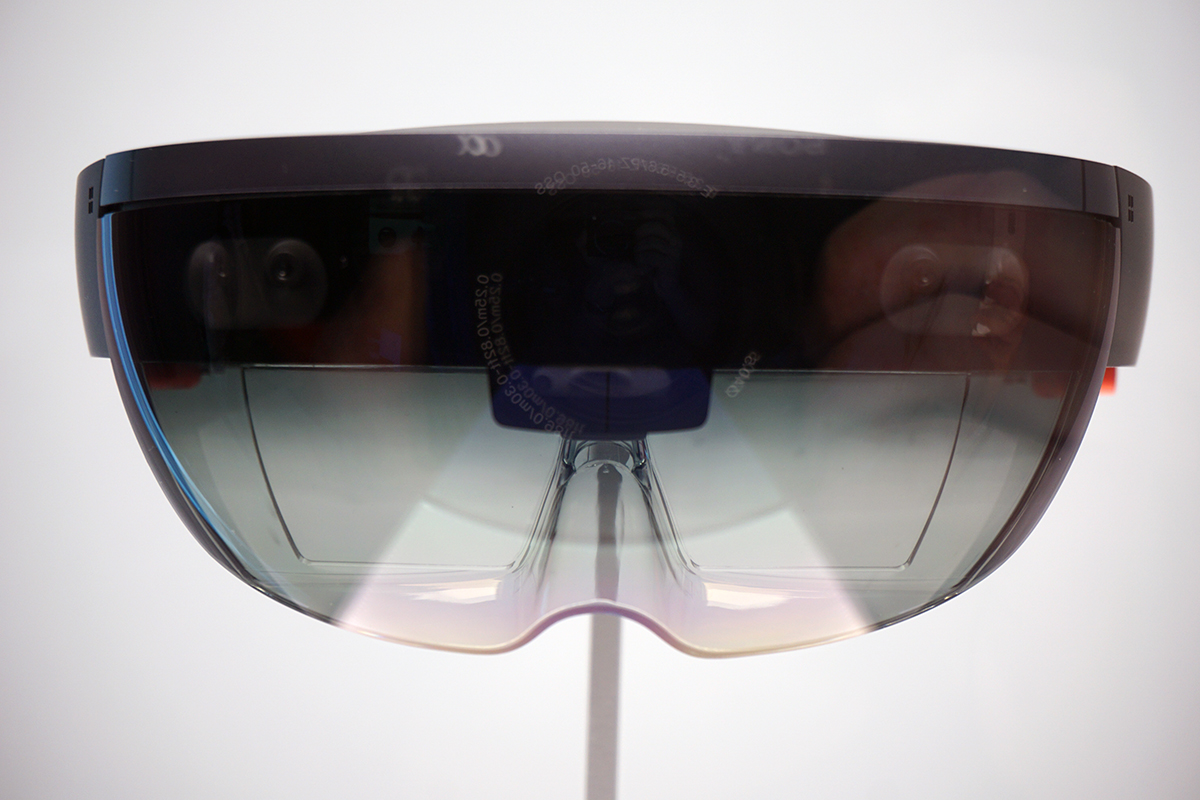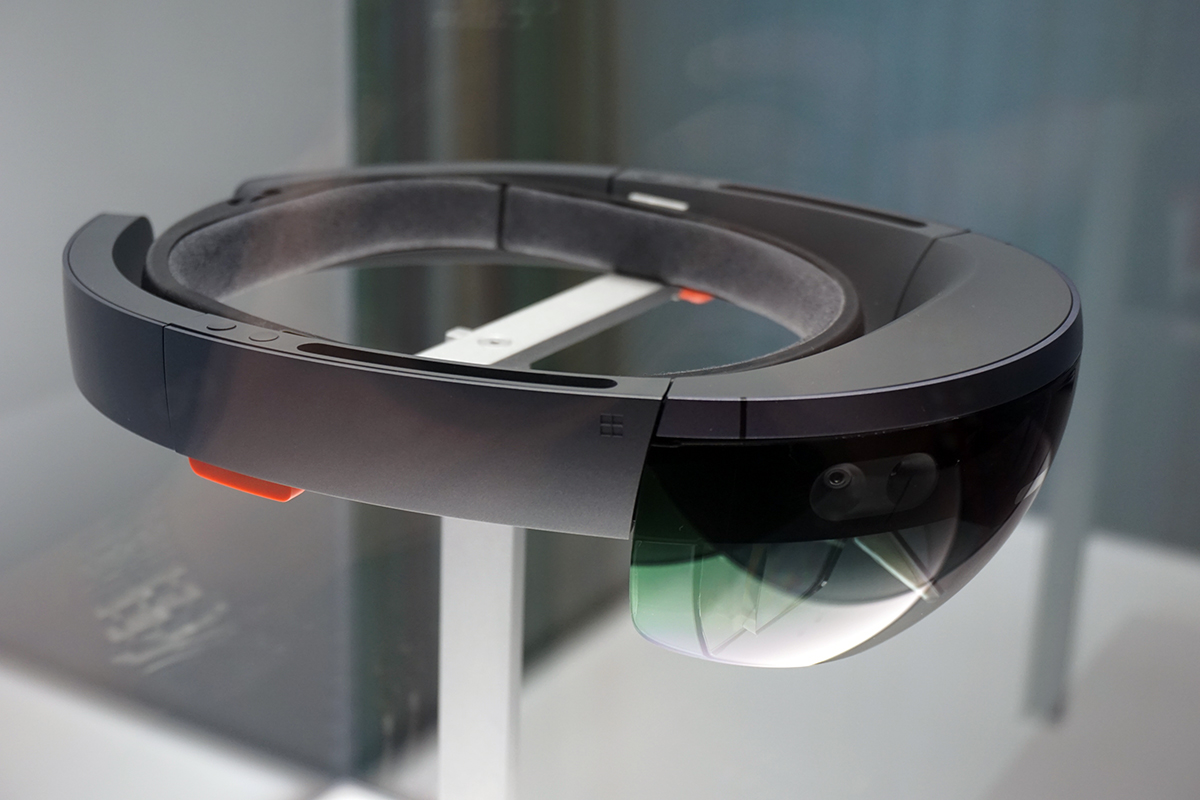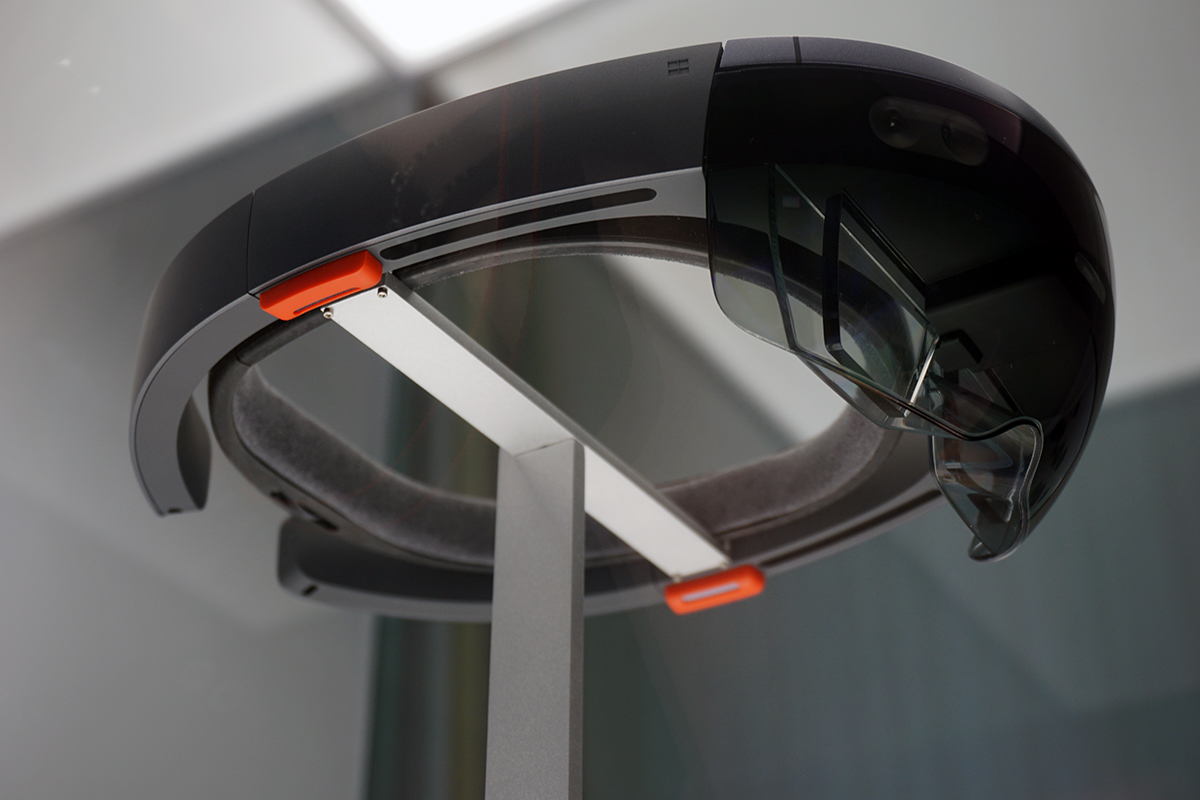Microsoft HoloLens, Hands On: Promising Productivity, Little Panache
Perhaps we're all just incredibly spoiled.
I got a hands-on look at Microsoft's HoloLens at Build 2015 today, and it wasn't really what I expected. Many of us in the tech media field have gotten used to seeing unbelievable things, and recently we've been privy to VR demos from the likes of Oculus and HTC and Valve that leave us with our jaws on the floor. My colleague's experience with the Vive VR actually brought him to tears, so powerful was the demo.
HoloLens is not that. And that's good, actually, because HoloLens is something different entirely, and that Thing is arguably more important than the awesome gaming or movie-viewing experiences we expect to have when those VR products finally land on store shelves. HoloLens is not sexy, and it's not especially mind-blowing. But it's also not too good to be true.
HoloLens felt like something that will be useful, something that people will use to get things done. To communicate. To play. To build, and sketch, and goof off, to teach, to problem-solve, to collaborate, and so on.
That's not to say that HoloLens is ready for primetime. The product certainly has a ways to go before I would say that it's retail-ready. However, it's mighty close, at least compared to where it was back in January.
It was just a few months ago that Microsoft debuted HoloLens at the Windows 10 event, and although the onstage demos were amazing, they were clearly staged. This week at Build, the onstage demos were actual demonstrations of the product's capabilities, shown in real time.
And tonight, I got to experience HoloLens first hand.
Get Tom's Hardware's best news and in-depth reviews, straight to your inbox.
Secrecy!
I should note at this point some important anecdotes. First, we were not allowed to take any photos or video of the demos. (Sorry.)
Second, the amount of secrecy involved with the entire thing was extraordinary. Members of the press were assigned times to attend the HoloLens demo, and we had to queue up in small groups in the Build press room at the appointed time, at which point we were escorted out of the building and down the block to a hotel. (A second location!)
There were blue-shirted Microsoft people everywhere in the hotel lobby, from hired-gun college kids to important HoloLens execs. We were ushered into the elevator, up several floors, at which point we spilled out into the 6th floor hallway and into the hands of another army of cheerful blue shirts.
They escorted us into a hotel room filled with lockers, where we had to sign in and ditch all our stuff. No cameras, phones, or recording devices of any kind were allowed beyond that point. No bags either, just to be safe. Microsoft actually handed out paper notebooks and pens to the lot of us. (Yours truly was already prepared with my trusty Moleskine notebook and analog stylus, so I declined the offer.)
"I feel naked without my gear," remarked one journo as we were shuffled off into a waiting area.
Our guide throughout was Andy Lutzky, one of the head PR mavens involved in HoloLens. Our group peppered him with questions, trying to get any extra juicy detail. He was flawless. "We are not discussing that yet," was his canned but friendly reply. And then he kept trying to change the subject.
The Skype Demo
Our next stop was a room that was set up in a similar way to the Build stage, a sort-of living room. We sat in rows like we were in a tiny theater, and two smiling twenty-somethings, Dan and Joe (who are actually working on HoloLens) strode to the front. Joe launched into a little memorized speech, telling us that we were about to enjoy a Skype demo.
At this point, we weren't donning the HoloLens ourselves. So we watched Dan and Joe. Joe was wearing a HoloLens, and Dan retreated to a room behind the stage.
Joe air-tapped Dan's icon to start a Skype call. Dan answered, and there was his full-screen visage floating in the air in front of Joe. "This is called a Video Card," noted Joe, breaking the fourth wall.
Joe could grab the Video Card of Dan's Skype call and drag it around. He eventually rested it on a table and pinned it there. HoloLens is smart enough to recognize surfaces, so it actually won't let you pull a window through it.
Joe was able to freely walk around the virtual Video Card, and he could still see Dan's face. Dan could see what Joe was seeing thanks to the HoloLens, but in that way they were able to interact more effectively.
Dan could even virtually reach through Joe's environment and annotate on an object. Dan created a 3D Minecraft model of the Space Needle and sent it to Joe through Skype. Joe opened it up and put it on the ground, and then Dan scaled it up so large that it was taller than Joe. Joe grabbed it and scaled it down small again, picked it up, and placed it on a shelf.
Next, the pair decided to collaborate on a 3D rendering of a cityscape. Joe pulled up a Video Card of OneDrive and opened a file. Dan made a few suggestions, Joe agreed on the changes. To kill the call, Joe simply said, "Skype, close." Dan edited the image, reactivated Skype, and sent Joe the file. Joe approved, shrunk it down, and placed it on the shelf next to the Space Needle.
The Construction Demo
We filed out of the Skype demo room, down the hall, back into the elevator, and up a couple dozen floors. Out of the elevator we came -- more blue shirts -- and we went down a long hallway to a room where they used a hand held tool to calculate our individual interpupillary distances (IPD), or the space between our eyeballs. I'm a 65, it turns out.
"It's not a competition, don't worry," quipped Andy. Even so, I couldn't help but be pleased to see that the fellow next to me had an IPD of merely 60.5. (Er, wait, is higher or lower better? Shoot.)
The pair of Microsoft reps in the IPD room also explained to us the three ways we were going to interact with HoloLens: "gaze," wherein you move a cursor by looking around; "gesture," where you air tap to select an item; and "voice," which is...obvious.
"We call it 'GGV'," said one of the reps. I wrote that down.
Next, we each were let into a private room for a private demo. There was a team of two in mine. It took both helpers to get me properly fitted with the HoloLens. They tilted the inner band of the headset at a angle, with the back part under the bulge at the back of my skull, and tightened the ring for a snug fit.
To accommodate my glasses, I could grab the arms of the front visor and slide them forward/up or backward/down. I was instructed to ensure that I could see all four corners of a rectangle displayed on the HUD in front of me.
I honestly didn't notice the weight of the HoloLens, because it was so tight. And although the visor did accommodate my glasses, there were a couple of pressure points. It felt a little awkward, though secure.
The HoloLens was completely untethered. There were no wires, no external cameras, nothing. It's a purely standalone device at this point, which in and of itself is impressive.
The field of vision is quite limited. I'd heard this was the case, but I assumed that the peripheral vision was occluded by the device itself. That's not the case; unlike a wraparound VR environment that's designed to be immersive, the HoloLens display is a smallish rectangle -- sort of like a TV screen sitting within your field of view.
It reminded me a bit of the Google Glass display -- a rectangle in space. The HoloLens display did not have perfect color. My demo unit had a slight rainbow effect on the right side, actually. I asked others if their displays had the same issue, and the feedback I got indicated that mine may have been a little worse than others.
In the demo, I saw a SketchUp 3D rendering (on a 2D display) of a proposed building. Next to it was an actual physical 3D model of the structures around the proposed site. My guide noted that the physical 3D model cost $12,000.
Through HoloLens, I saw a 3D projection of the new building on top of the physical model. On the monitor, I could click and drag parts of the building and raise them up or shrink them down, and my adjustments reflected on the hologram in real time. There was no discernible lag between my mouse events on the monitor and that of the hologram, which I found impressive.
Next, I moved the mouse cursor from the 2D monitor to my view of the hologram. (Effectively, the hologram was simply a screen extension of the drawing on the monitor.) Again, there was no lag.
I clicked a spot on the hologram with the mouse, and suddenly I had a photo rendering of the area in Denver I was supposed to build in. I looked around the room, all 360 degrees, and I could see a 360-degree view of Denver. Again, there was no lag, unless I really moved my head as quickly as possible. (Are you seeing a theme here?)
In the second part of this demo, I walked over to a tiny room where I could see a projection of a sort of blueprint on a wall. It was as if I could see through the wall and down the street, thanks to the holographic projection.
My guide noted to me that I was looking at plans to build a door, but when I "looked through the wall" we were supposed to knock down to make the opening, there was a steel beam in the way. When I looked directly at the beam, the cursor attached to my eyes, where I was looking, "booped" to indicate that the beam was something I needed to interact with.
I looked over, and there was a 3D avatar of a man. I talked to him. He noted the beam issue, and we moved the proposed door opening a bit to the right. However, as I could see thanks to the see-through hologram of the wall space, there was now a pipe that was in the way.
I air-tapped the pipe to leave a note. I said, "Move pipe," and my note was there for my avatar friend to take care of on his end.
I expected the air tap to be a cumbersome, annoying command to get used to, but it was just the opposite. Not only did HoloLens catch my finger movements, it responded immediately -- no lag -- and furthermore, I didn't have to necessarily hold up my arm in space. As long as I was looking directly at something, with the cursor (which appears as a tiny translucent white dot in your vision) on that something, I could actually air tap with my hand down almost resting at my side.
The avatar, by the way, could be anything. In this case is was a blue facsimile of a man, but it could be an elephant, or a stick, or if you're brave, Cortana. It's simply something for you to interact with; it's not a direct representation of the person you're communicating with.
As I noted above, the HoloLens did not feel quite like a consumer-ready product. However, the demos did show many of the potential uses for the headset, and although the limited display size was a notable limitation, the device did a marvelous job of providing a snappy, lag-free, intuitive user experience. There was virtually no learning curve.
I can see the HoloLens being a valuable tool for industrial uses, teaching and training of various kinds, and even fun home uses such as Skype calls, watching TV, and more. Microsoft needs developers to buy in, of course, but from what I saw, there's no reason why they shouldn't. If writing Universal Apps that translate with ease to HoloLens is as simple as Microsoft made it seem this week, devs should be lining up.
The demo ended, and I was back in the hallway and joined my group members as they trickled out from their own demos. More blue shirts. If I was a more paranoid person, I would have counted them. But there were dozens, at least.
We took the elevator down to the main floor, tried to pry some last-minute info from Andy (he was a rock), and suddenly we media members were outside, strolling down the San Francisco sidewalk, back to Moscone West, picking each others' brains about what we just witnessed.
Seth Colaner is the News Director at Tom's Hardware. Follow him on Twitter@SethColaner. Follow us @tomshardware, on Facebook and on Google+.
Seth Colaner previously served as News Director at Tom's Hardware. He covered technology news, focusing on keyboards, virtual reality, and wearables.
-
DelightfulDucklings Nice write up, everything I read about Hololens seems to make it more and more promising, the limited field of view can surely be fixed with improved technology so hopefully by the time it goes retail it is able to cover almost your entire vision. Overall seems like an incredible piece of technology, I can't get over the fact of how sci-fi it seems.Reply -
tomfreak next they gonna shrink the entire thing into contact lens = Hello there, I I have the technology like how Ironman use...JarvisReply -
Geef Yes, it does sound a lot like Jarvis from Ironman. They just need to get people to watch those movies if they haven't seen them and everyone will be full blown into this.Reply



